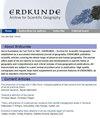Climate and environmental context of the Mongol invasion of Syria and defeat at ‘Ayn Jālūt (1258–1260 CE)
IF 1.1
4区 社会学
Q3 GEOGRAPHY
引用次数: 2
Abstract
After a successful conquest of large parts of Syria in 1258 and 1259 CE, the Mongol army lost the battle of cAyn Jālūt against Mamluks on September 3, 1260 CE. Recognized as a turning point in world history, their sudden defeat triggered the reconfiguration of strategic alliances and geopolitical power not only in the Middle East, but also across much of Eurasia. Despite decades of research, scholars have not yet reached consensus over the causes of the Mongol reverse. Here, we revisit previous arguments in light of climate and environmental changes in the aftermath of one the largest volcanic forcings in the past 2500 years, the Samalas eruption ~1257 CE. Regional tree ring-based climate reconstructions and state-of-the-art Earth System Model simulations reveal cooler and wetter conditions from spring 1258 to autumn 1259 CE for the eastern Mediterranean/Arabian region. We therefore hypothesize that the post-Samalas climate anomaly and associated environmental variability affected an estimated 120,000 Mongol soldiers and up to half a million of their horses during the conquest. More specifically, we argue that colder and wetter climates in 1258 and 1259 CE, while complicating and slowing the campaign in certain areas, such as the mountainous regions in the Caucasus and Anatolia, also facilitated the assault on Syria between January and March 1260. A return to warmer and dryer conditions in the summer of 1260 CE, however, likely reduced the regional carrying capacity and may therefore have forced a mass withdrawal of the Mongols from the region that contributed to the Mamluks’ victory. In pointing to a distinct environmental dependency of the Mongols, we offer a new explanation of their defeat at cAyn Jālūt, which effectively halted the further expansion of the largest ever land-based empire.蒙古入侵叙利亚和在Ayn Jālāt战败的气候和环境背景(公元1258年至1260年)
在公元1258年和1259年成功征服了叙利亚的大部分地区后,蒙古军队在公元1260年9月3日与马穆鲁克人的凯恩战役Jālūt中失利。他们的突然失败被认为是世界历史上的一个转折点,不仅在中东,而且在欧亚大陆的大部分地区,引发了战略联盟和地缘政治力量的重新配置。尽管经过了几十年的研究,学者们对蒙古人逆行的原因尚未达成共识。在这里,我们根据过去2500年来最大的一次火山喷发(公元1257年的萨玛拉斯火山喷发)造成的气候和环境变化,回顾了以前的论点。基于树木年轮的区域气候重建和最先进的地球系统模式模拟显示,从公元1258年春季到1259年秋季,地中海东部/阿拉伯地区的气候更冷、更湿润。因此,我们假设萨马拉斯之后的气候异常和相关的环境变化在征服期间影响了大约12万蒙古士兵和多达50万匹马。更具体地说,我们认为公元1258年和1259年较为寒冷和潮湿的气候,虽然使某些地区(如高加索和安纳托利亚的山区)的战役变得复杂和缓慢,但也促进了1260年1月至3月对叙利亚的攻击。然而,公元1260年夏天又回到了温暖干燥的环境,这可能降低了该地区的承载能力,因此可能迫使蒙古人大规模撤出该地区,而这正是马穆鲁克人取得胜利的原因。通过指出蒙古人对环境的独特依赖,我们为他们在凯恩Jālūt的失败提供了一种新的解释,这有效地阻止了有史以来最大的陆上帝国的进一步扩张。
本文章由计算机程序翻译,如有差异,请以英文原文为准。
求助全文
约1分钟内获得全文
求助全文
来源期刊

Erdkunde
地学-自然地理
CiteScore
2.00
自引率
7.10%
发文量
17
审稿时长
>12 weeks
期刊介绍:
Since foundation by Carl Troll in 1947, ''ERDKUNDE – Archive for Scientific Geography'' has established as a successful international journal of geography. ERDKUNDE publishes scientific articles covering the whole range of physical and human geography. The journal offers state of the art reports on recent trends and developments in specific fields of geography and comprehensive and critical reviews of new geographical publications. All manuscripts are subject to a peer-review procedure prior to publication. High quality cartography and regular large sized supplements are prominent features of ERDKUNDE, as well as standard coloured figures.
 求助内容:
求助内容: 应助结果提醒方式:
应助结果提醒方式:


